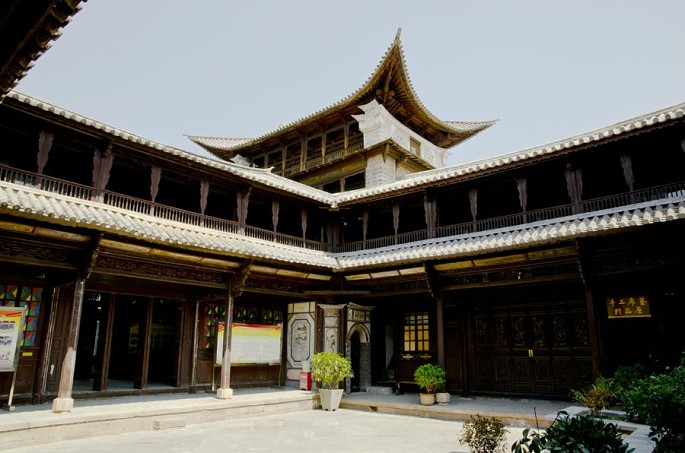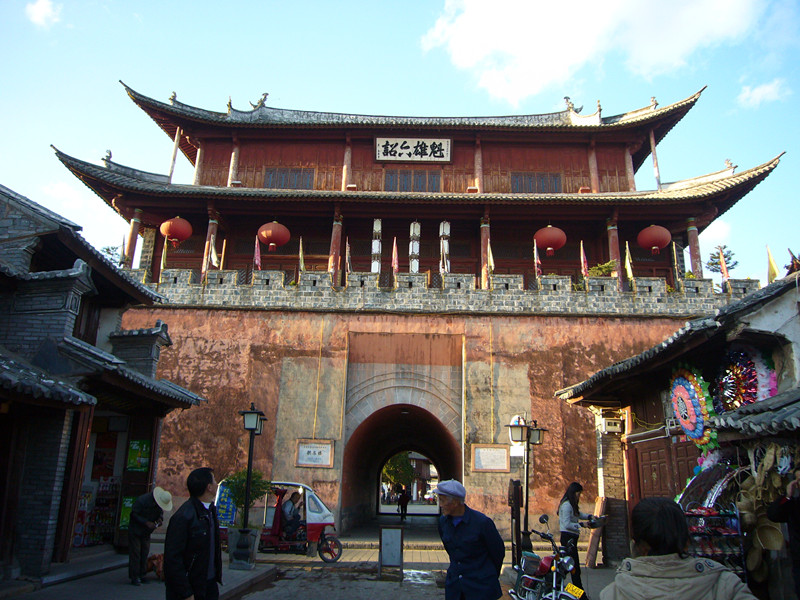
Donglianhua (东莲花) is part of Yongjian County (永建镇), which sits on the very northern edge of the Weishan plain, 35 kilometers south of Dali Old Town. Other than Ningxia and parts of Gansu and Xinjiang, it is one of the most obviously Muslim areas in China.The hamlet is mainly inhabited by Hui Muslims and has a large mosque. The Ma family build three impressive courtyard homes with the money they made with trade along the packhorse routes.

The imam of the village mosque says there are an additional 22 mosques scattered across the plain — and Donglianhua's is far from the largest. The prayer hall there can hold 1,000 people. Three kilometers to the south, the imam said another mosque had room for 6,000 to pray simultaneously.

The people of the area belong to the Hui minority (回族) and most are descended from members of Muslim regiments in the Mongol army that conquered Yunnan in the 13th century. Some of those soldiers stayed in Yunnan. Initially they were there to keep the locals in line and later they became farmers and, more importantly, traders.

Much like their ancestors, members of the Hui Muslim communities have continued to live itinerant lives since coming to Yunnan. They rose to dominate the caravan trade in southwest China, creating merchant networks that spread far into Southeast Asia.
After the Panthay Rebellion was put down in 1873, Yunnan's Muslim people suffered a series of persecutions. Many fled Yongjian along the Burma Road, settling into a large Chinese Muslim population in Myanmar. This gave the Hui who stayed behind even stronger economic ties along the old caravan trails to Myanmar and beyond.
Donglianhua's opulent buildings were built largely by three brothers surnamed Ma (马) — Ruqi (如骐), Ruji (如骥) and Ruqing (如清) — who became the village's most successful caravaneers. Records are sketchy, but it appears the eldest, Ma Ruji, was born in Donglianhua in 1897.
He died in Chiang Mai, Thailand in 1983. Ma Ruqi also moved to Thailand where in 1974 he became head of the Chinese Business Association there. In 1988 he put one million Thai Baht toward the renovation of Donglianhua Mosque.
The mosque courtyard is listed in historical records as having belonged to Ma Ruqi. It is now in the hands of one of his descendants, who runs a restaurant inside the mosque with the aid of his wife. Curiously, Mr. Ma the restaurateur claimed not to know what had become of his eminent great-uncle.
From the watchtower at the back of the mosque complex there is a fine view across the village in all directions. It offers a more complete and unspoiled view of a wealthy Qing/Republican-era village than similar views in better-known Xizhou.
Like the merchants of Xizhou, the Ma brothers made great fortunes during World War II. Their trading connections and caravans were engaged in the effort to bypass the Japanese blockade and bring supplies into Yunnan. The largest of the Ma courtyards, which is currently being redeveloped as a "Caravan Culture Museum," was originally built in 1941.
The lovely Yongji Bridge, however, testifies to a much longer history of caravan trading in this part of Yunnan. The bridge was first built in 1573. It stands just a few kilometers to the northwest of Donglianhua and, if judged by the modern roads, leads nowhere in particular.
Take those roads away from the map, however, and sketch the main caravan routes from Weishan (魏山) to Dali and from Dali to Myanmar. Yongji Bridge clearly becomes part of a fine short-cut from Weishan to Yongping (永平) and thence to Baoshan into Myanmar.
This area's historic links with Myanmar had unfortunate consequences. After World War II, illegal drugs became a mainstay of that country's economy. Chinese Muslims in Myanmar and Thailand, all with family ties to Yunnan, were heavily involved in the trafficking of the drugs through Southeast Asia. They used the same caravans and routes that had once transported tea, jade and silk to instead traffic narcotics.
As the Chinese economy opened up in the 1980s, the drug traffickers saw an opportunity to exploit their family ties and trading connections. The Yongjian area thus became a major center for illegal drug trading, culminating in its designation in 1999 as one of China's 17 "National Serious Drug Problem Areas."
Between 1983 and 1999, an average of 200 people from Yongjian were arrested every year for drug offenses in other parts of China. In Yongjian itself, 2,509 people were arrested for drug offenses over the same time period.
Inside the courtyard of the Donglianhua Mosque a blackboard obliquely mentions these past events. The slogan on the board instructs worshipers to "Love their country and obey the law." In the background are more slogans emphasizing the need to follow the law and unite harmoniously with China's other peoples.
It took military force to deal with the caravan drug rings. In an episode that is well-known around Yongjian, army units fought well-armed locals in 1999. Today it was not an easily broached question and not something that has been written about.
The only publicly available statistics regarding these events refer to the nearby village of Mashuichang (马水场). Out of 21 households, 19 were said to have been involved with drugs in some capacity. Seventeen people were officially "dealt with." Six were reported killed in the fighting and two were executed. In 2009 the village, and presumably the area, was said to be completely drug free.
Getting there
Donglianhua is 35 kilometers south-southwest of Dali Old Town. First take a bus from Dali's Dongzhan (东站) bus station — which is located next to the Dali Train Station — to Weishan. Tickets should cost 10-15 yuan. From there, Donglianhua is three kilometers away and can be reached on foot, by horse cart, motorbike or taxi.
Admission Fee:¥0

You will only receive emails that you permitted upon submission and your email address will never be shared with any third parties without your express permission.
